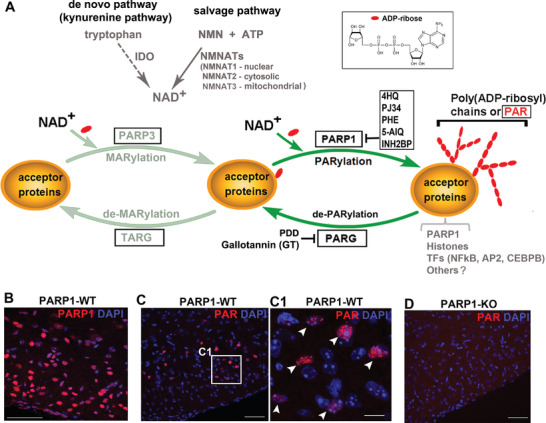Figure 1.

ADP‐Ribosylation and representative catalytic enzymes. A) Protein ADP‐ribosylation consists of mono‐ADP‐ribosylation (MARylation) and poly‐ADP‐ribosylation (PARylation) which are catalyzed by mono‐ADP‐ribosyl transferases (such as PARP3) and poly‐ADP‐ribosyl transferases (such as PARP1), respectively, by using NAD+ as the donor of ADP‐ribose unit. NAD+ is replenished and synthesized primarily through the salvage pathway catalyzed by the rate‐limiting enzyme NMNATs and, to a lesser extent, through the de novo kynurenine pathway catalyzed by the rate‐limiting enzyme IDO. B–D) immunohistochemical staining of PARP1 and PAR in the spinal cord of PARP1 wild type(WT) and PARP1 knockout(KO) mice of postnatal 10 days. Boxed area in (C) is shown at higher magnification images in (C1). Note that PARP1 deficiency abolished the nuclear PAR signal, suggesting that PARP1 is the predominant PARP responsible for PARylation in the CNS. Scale bars: 100 µm, (B,C,D); 10 µm, (C1). Abbreviations: NAD+, nicotinamide adenine dinucleotide; MNN, nicotinamide mononucleotide; ATP, adenosine triphosphate; PARG: poly ADP‐ribose glycohydrolase; TARG, terminal ADP‐ribose glycohydrolase; IDO, indoleamine 2,3‐dioxygenase; NMNATs, nicotinamide mononucleotide adenylyltransferase. PARP1 inhibitors: 4HQ, 4‐hydroxy‐quinazoline; PJ34, N‐(6‐oxo‐5, 6‐dihydrophenanthridin‐2‐yl)‐(N,‐dimethylamino) acetamide hydrochloride; PHE, 5(5H)‐phenanthridinone; 3AB, 3‐aminobenzamide; 5‐AIQ, 5‐aminoisoquinoline. PDD, PDD 00017273, a potent and selective inhibitor for PARG.
